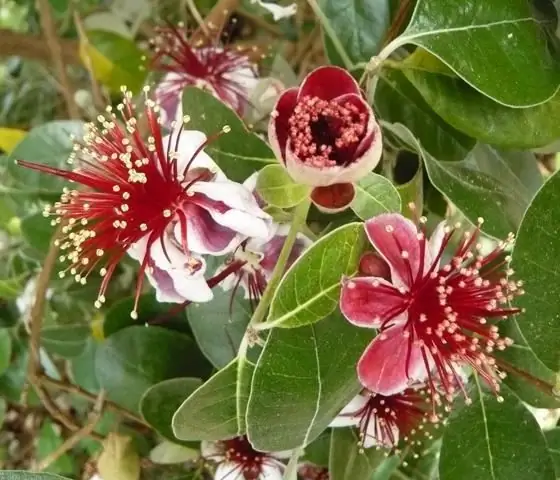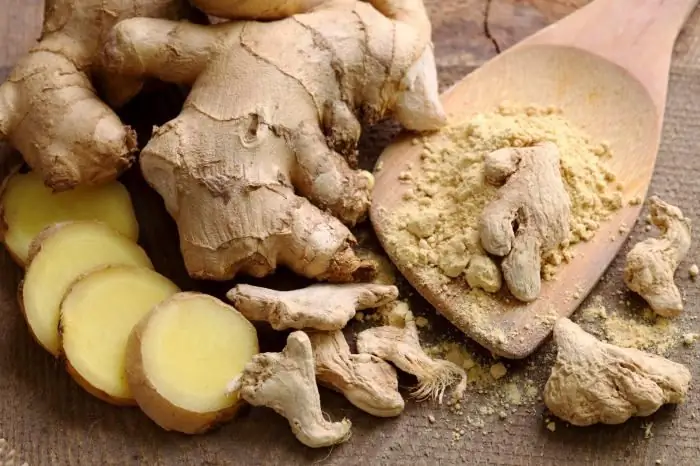2026 Author: Isabella Gilson | [email protected]. Last modified: 2025-01-23 12:50:33
The Japanese islands are surrounded on all sides by the ocean, so there is nothing surprising in the fact that the menu of the inhabitants of the Land of the Rising Sun consists of 80% of seafood. And this is not only waterfowl, but also plants. There are 30 species of edible algae in Japan alone.
Kombu stands out among them. The scientific name of this algae is Japanese kelp. In Korea, the plant is called tashima, and in China, haidai. But in Japan they managed to develop several varieties of kombu that differ in taste: karafuto, ma, mitsushi, naga, rishiri.
Despite the fact that most seaweed farms are concentrated in Hokkaido, it has become a staple for the inhabitants of all the islands. In Japan, kombu is as popular as cabbage or potatoes in Russia. Soups are cooked from it, main dishes and even desserts are made from it. This article will cover how to cook kombu seaweed. In addition to recipes, the beneficial properties of this plant will be described.
What do Russian consumers need to know about kombu?
If you hitto the city of Osaka, you can buy about a hundred varieties of Japanese kelp there. It is sold fresh for sashimi. Seaweed marinated in vinegar is called su kombu. You can also buy seaweed strips in mirin soy sauce.

With green tea, the Japanese eat a special snack - kombu stalks in a sweet and sour marinade. You can also make a drink from seaweed. Kombutya is a tea brewed from powdered kelp. But since the product is imported into Russia, you can most often find dried algae in specialized stores (photos of the kombu are presented in the article).

Dashi (dried strips or powder) and boro (shavings) are most often packaged products. You can also find canned or freshly frozen seaweed. Each species is used by the Japanese for certain dishes. But since mostly dried seaweed is available in Russia, it is worth considering what can be prepared from them.
Useful properties of kombu
Before giving recipes for dishes that include Japanese kelp, let's study the chemical composition of the plant. You should know that the upper parts of the algae are less rich in nutrients than the basal ones.
But they also contain a lot of iodine, which is important for the thyroid gland. The whole plant is rich in vitamin A, the whole range of B, C and E, as well as minerals - sodium, calcium, potassium, manganese, phosphorus, iron, zinc, magnesium and copper.
Kombu algae are valued for their glutamineacid. It is a natural flavor enhancer. But glutamic acid also brings invaluable benefits to the body, as it normalizes metabolism and strengthens the immune system.
The protein contained in the algae slows down aging, and the fiber cleanses the stomach and helps digestion. If you eat kombu often, you can prevent the risk of cardiovascular disease and clogged veins.
Dashi broth for miso soup
As in Ukraine borscht, and in Russia cabbage soup, this soup is popular in Japan. There are hundreds of varieties of miso. Each family cooks it differently. But, despite the huge number of species, two components of the soup remain unchanged. This is miso paste made from soy and dashi - kombu seaweed broth.

Make more of the last miso ingredient. Dashi will be the basis for other Japanese soups or seasoning for boiled rice. This broth is boiled with fish, less often with seafood.
- Put a small piece of dried seaweed in a saucepan along with 20 grams of tuna.
- Pour four glasses of water. Bring to a boil.
- Reduce heat and cook for 5 minutes.
- Strain dasha broth.
Now you can start making the miso soup itself.
Salmon soup with noodles
Let's consider the most common version of the famous Japanese dish - with fish.
- Into strained kombu and tuna dashi broth, add 200 grams of salmon cut into small pieces.
- Cook until tenderfish.
- Pour a ladle of soup into a bowl.
- Add soy paste for miso. She is red. In Japan, it is called akamiso. There is also white pasta based on rice, barley or wheat, as well as mixed varieties. For this recipe (with salmon), we use three tablespoons of akamiso.
- Dilute the mixture well. Pour back into the saucepan.
- Add also a teaspoon of other dried seaweed - wakame. Let's wait a minute for them to steam up.
- In parallel with the miso cooking process, boil the egg noodles in s alted water.
- Drain it from boiling water.
- Chop a few green onions finely.
Serve miso traditionally in small bowls. First, put the noodles there. Someone likes more thick, someone - thinner. The noodles are poured with soup, trying to get a piece of salmon into the bowl. The finished dish is sprinkled with green onions.
Another option: shrimp miso soup
To prepare this soup, you can use the traditional dashi broth - dried kombu seaweed and tuna chips. But for a more intense seafood smell, replace the fish with large shrimp shells (or whole small crustaceans).

Don't forget to strain the dashi broth through several layers of gauze.
- Pour a glass (or ladle) into a bowl, cool, dissolve the paste in it. It can be either red akamiso, white shiromiso, or a mixture of two types - awashemiso. As in the previous recipe, 3 tablespoons of pasta are required.
- When yourub all the lumps, pour the mixture into the rest of the broth, which should already be hot by then.
- Quickly add the rest of the miso soup ingredients: 150 grams of peeled shrimp and about the same amount of diced tofu cheese, a teaspoon of dried wakame seaweed.
- Bring the soup to a boil and immediately turn off the heat.
- Let's brew under the lid for five minutes.
- Pour the finished dish into bowls and sprinkle with chopped green onions.
Other kombu seaweed recipes. Zucidani snack
This amazing Japanese appetizer is quite easy to make.
- We take a piece of dry seaweed weighing 15 grams and soak it for a quarter of an hour in half a glass of water.
- When the kombu becomes soft, cut it into thin and long strips like a Korean carrot.
- Move it to the saucepan.
- Add half the amount of water in which the seaweed was soaked, and add half a teaspoon of rice vinegar.
- Bring to a boil over low heat and cook after boiling for ten minutes.
- Add a quarter cup of soy sauce, a tablespoon of sugar, mirin and sake to the saucepan.
- Cook until the liquid is almost completely evaporated.
- Remove the saucepan from the heat and add a teaspoon of sesame seeds.
- Stir and serve appetizer immediately.

Unagi "Yanagawa"
This extremely thick soup is popular far beyond Japan.
- To prepare it, mix 3 grams of dried kombu seaweed and a teaspoon of sugar in one saucepan.
- Add 20 ml of soy sauce, the same amount of rice wine (mirin) and 120 ml of plain water.
- Put on fire, bring to a boil.
- Add tuna shavings (5 grams). Immediately remove the broth from the fire and strain.
- In a separate bowl, mix a raw chicken egg and a handful of arugula (or lettuce leaf torn by hand).
- A few shiitake mushrooms and half a bunch of green onions cut into large strips.
- Put these ingredients in a cold pan.
- Smooth out the layer. On it we will place one hundred grams of smoked eel, cut into slices.
- Pour the broth over it all.
- Put the pan on the fire, bring its contents to a boil.
- Quickly pour in the egg with herbs. We immediately serve the dish to the table.

Jiao Xiang Haidai Si
As experienced travelers assure in their reviews, kombu seaweed has become a staple not only in Japanese but also in Chinese cuisine. We invite you to cook a delicious salad "Jiao Xiang Haidai Si".
The name of the dish simply translates to "Spicy kombu seaweed appetizer". We need a small piece of the root part of the kelp. It is desirable that it be fresh or frozen, not dried. If the seaweed is dry, cook it in a double boiler for half an hour, sprinkling the plant with rice vinegar in the middle of the process.
- Kombu cut into thin long strips, three cloves of garlic - smallcubes.
- Select seeds from green and red chili peppers.
- Pulp cut into strips. Soak it in water.
- Preparing salad dressing. In a bowl, mix garlic, a teaspoon of sugar, a tablespoon of rice vinegar, a pinch of s alt, a few drops of sesame oil and light soy sauce.
- Shake until crystals dissolve.
- Blanched kombu seaweed for a few minutes, drain in a colander.
- Mix with peppers (they need to be squeezed well).
- We dress the salad with prepared sauce.

Shabu-shabu
Cooking this soup like this.
- First brew dashi broth with water, kombu seaweed, soy sauce, tuna flakes and a glass of sake.
- Cut the tofu into cubes, spinach into strips, leeks into oblique circles, and marbled beef into thin slices.
- On the shiitake caps, we will make cross-shaped incisions, chop the onion and Chinese cabbage.
- Put the mushrooms into the broth first, then the rest of the ingredients.
- When all the ingredients are ready, serve with soy or nut sauce.
- Separately three daikon radish.
This dish is eaten in two stages. First, the ingredients of the first series are fished out of the broth. Then udon noodles are lowered into the liquid and cooked according to the instructions for it. It is transferred to bowls, poured over with a small amount of broth and soy sauce with lime juice.
Recommended:
Pistachio oil: useful properties, uses and contraindications

If you see pistachio oil in the store, be sure to buy a bottle. This is a valuable natural product with a unique composition, known and revered in folk medicine since the time of Avicenna. We will talk about the calorie content of pistachio oil, useful properties and contraindications, as well as its use for medicinal and cosmetic purposes
Yellow cherry: description, useful properties and best recipes. Seedless yellow cherry jam - recipe and cooking features

Yellow cherry is a tasty and he althy product. From sweet berries you can make delicious jam, a delicious dessert or a pleasant soft drink. Today we want to take a closer look at the beneficial properties of cherries, as well as share the secrets of its preparation at home
How is feijoa useful and for what diseases? Feijoa fruit: useful properties, contraindications, photos and recipes. Feijoa jam: useful properties

When berries similar to gooseberries appeared on store shelves a few years ago, people hesitated to buy them for a long time. But, having figured it out and tried it once, they began to consider them an ordinary fruit, the name of which is feijoa. Over time, it became known that feijoa is useful
Ginger: useful properties and contraindications for women. Pickled ginger: useful properties

Each country has its own tradition of using ginger. So, the horned root in Asia, considered the birthplace of the plant, is a universal remedy for many diseases. In China and India, eating ginger is believed to promote a long and he althy life
Dates: useful properties and contraindications. Useful properties of dried dates

Dates are not only an oriental sweetness, but also a storehouse of vitamins. They are rich in nutrients and are also a natural cure for many ailments

